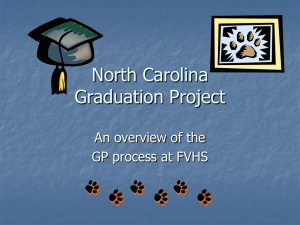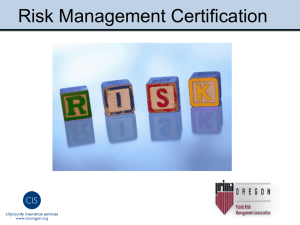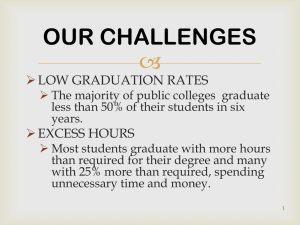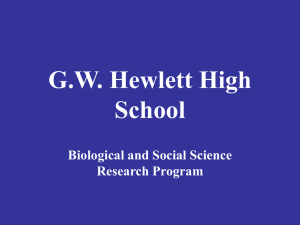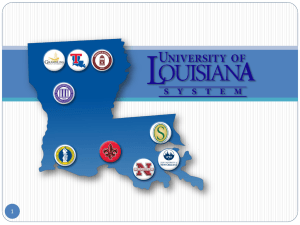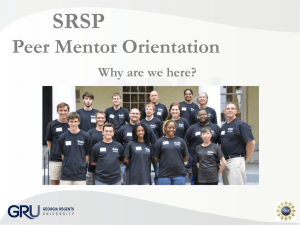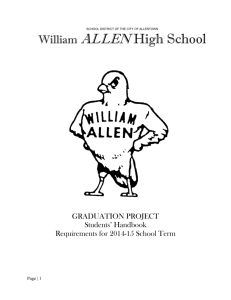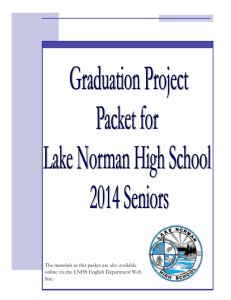NC GP Powerpoint for Students REVISED
advertisement
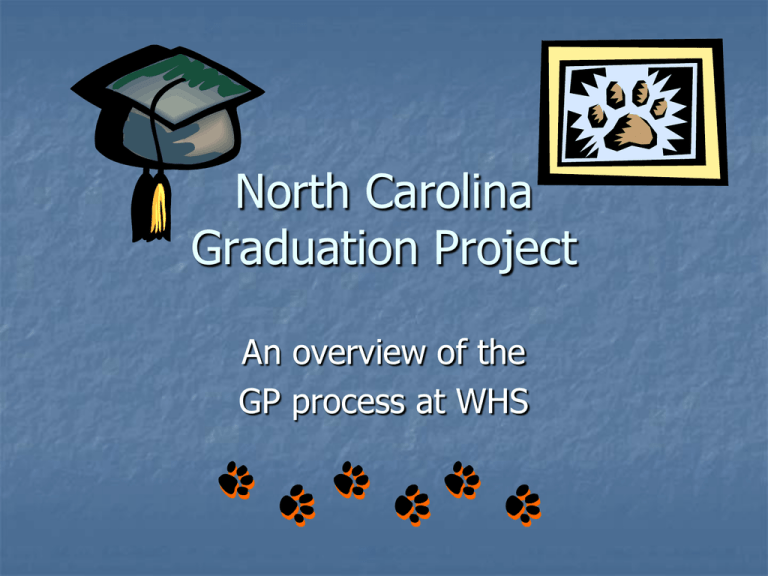
North Carolina Graduation Project An overview of the GP process at WHS What is the purpose of the GP? Promotes the learning and skills needed to be successful in college, the world of work, and as life-long learners. Encourages community members to get involved with the education of all students. Make students “stretch,” meaning students will go beyond prior knowledge and work toward a goal in which they have a passion. What is the purpose of the GP? cont. Provides a multi-disciplinary assessment, that allows them freedom, unlike performance based tests. Students gain confidence and self-esteem needed for success in our ever-changing world. The value of learning is reinforced, and students will be able to “show-off” their hard work. Components of the GP An MLA-STYLED RESEARCH PAPER— 5-7 pages (standard), 7-10 pages (honors), or 10-12 pages (AP) using 1 source per page (varies by teacher) A PRODUCT—an extension of your research requiring students to work with a community mentor. A PORTFOLIO—compiling & showcasing a student’s work through written and photographic evidence throughout the GP process A PRESENTATION—10-12 minutes in length for 3-4 community judges at the conclusion of English IV. Some Restrictions… Must be student generated. Must be of sufficient depth to reflect extensive study and learning. Must be approved by the academic advisor and parents/guardian. Must show evidence of knowledge gained in the completion of the research. Should not require large monetary expenditures. The Research Paper Completed during the junior year. Appropriate topics will be of genuine interest to you be a learning stretch not be immoral, illegal, or contrary to WCS policies be approved by parents have 5-7 sources of available research be worthy of a 5-7 page paper, preferably with 3-4 specific areas for development have available experts who are willing to serve as mentors lend themselves to a feasible product not be a “how to” be approved by the WHS steering committee The Product--Requirements Must be a learning stretch Must reflect a minimum of 15 hours. (This may include fieldwork time learning the skill as well as time creating the actual product.) Must be created with the assistance of an approved mentor Must illustrate a connection to paper topic and research Must demonstrate a connection to the real world. The Product—What is it? A product can be a physical creation build a guitar make a documentary create blueprints for a house develop a business plan write a children’s book plan, organize, and manage a large fundraising event The Product—What is it? A product can be an earned certification that meets the 15 hour requirement SCUBA Certification Fire Safety Level I Certification Motorcycle Driver’s License Certification Hospice Volunteer Certification Red Cross Emergency Response Certification The Product—What is it? A product can be a demonstration of an acquired skill to a third party Take salsa dancing lessons and demonstrate your skills to a girl scout troop Learn how to prepare sushi and hold a sushi tasting party Learn how to play the guitar and perform a song for your church The Product—How do I show proof of accomplishment? Certifications and many physical products can be brought directly to school All demonstrations of acquired skills must be documented on video or in photographs Videos, electronic presentations (Powerpoint, etc.), trifold boards, and/or scrapbooks may be used for some products (ex: lesson, fundraiser, interior design, volunteerism, etc.) What is NOT a product? Visual presentation of research Simplistic visual aids, such as pamphlets, Powerpoints, tri-folds, etc. (These items can enhance a product and may prove a product but cannot be the product.) Something generated by a paid position or other class assignments Documentation of job shadowing/mentor work Some Example Research Topics to Products by Subject Dance A student analyzed the life and style of dancer and choreographer Martha Graham and the relationship to women in the arts, and how she expressed the American experience in her choreography. Her product was an original student-choreographed work in Graham’s style based on themes of contemporary American life. English as a Second Language A student researched the effects of immigration to the US on children. The student then volunteered time as a youth director at a local organization to help develop a program to assist teenage immigrants in adjusting to their new community and country Mathematics/Computers A student designed and built a deck according to a designed draft after researching local regulations and building techniques. A student explored the use of online games as a tool for learning. After researching and taking lessons in game design, student developed games for students to use to prepare for summative assessments. Music A student researched how music records and reflects historical and political events. The product was an original musical composition aligned with the current war in Iraq, expressed a personal political statement about the student’s experience, feeling, and hopes. Some examples of some local product ideas Quilting Gardening/Landscaping Restoring Vehicles/Antiques Various Types of Photography What will this cost? The Graduation Project should not be expensive! Some students choose topics and products that require additional expenses. Spending extra money is NOT a requirement. The Graduation Project can be successfully completed with little to no cost. Any financial hardships should be reported immediately to the Guidance Counselors at your high school so they can possibly assist the students. The Presentation—What is it? Speech (10-12 minutes) Speech given to a panel of community judges and/or teachers. Use of technology is strongly encouraged (Audio/Visual aids). Question & answer session with the judges will follow presentation. The Portfolio—What is it? Students will keep an ongoing portfolio documenting work & time spent on the GP. A list of the required pieces & their due dates will be given during your senior English class Two parts of the Portfolio, the Letter of Intent & the Research Paper, will be completed during the student’s junior year. Anything related to the completion of the project will go into the portfolio, including a final copy of the students’ research papers. What can parents do to help? Review the Graduation Project requirements & sign required forms. Talk with your student about the Graduation Project. Pay attention to the timeline to assist your student with meeting deadlines. Offer guidance with topic selection. Pay attention to cost, time constraints & transportation issues. What can parents do to help? Know and approve of your students mentor. Routinely access the school’s Graduation Project webpage. Offer support to your student while he or she is writing the paper, creating the product, building the portfolio and practicing for the presentation. Encourage your student to partner with an in-house advisor (if applicable) What if I enroll into WHS late? The Graduation Project and its elements are still required. 1. Students enrolled at the beginning of their senior year are still required to complete the full Graduation Project requirements. Students may use a research paper from their previous school provided it earned a score of a C or better. 2. If there is no previous paper, students are expected to write a minimum five page research paper to use as the baseline for their Graduation Projects/Presentation. Students are expected to seek help from a faculty member on writing their paper if needed. What if I enroll into WHS late? The Graduation Project and its elements are still required. 1. If the student enrolls late into the spring semester, the student will be asked to complete a scaled-down version of the paper and project that will be determined by the student’s English teacher. That teacher will also be expected to inform the project judges as well. So in a nut shell students have to: Write a RESEARCH PAPER (Jr. Eng.) Compile a PORTFOLIO (11-12) Includes Letter of Intent, Research Paper, 3 Reflections, & misc. forms from the handbook as documentation Create a PRODUCT (at home) Topic of interest/Essential Question Something that can demonstrate a TANGIBLE learning process of paper topic Do a PRESENTATION (Semester of Sr. Eng.) Describe all four parts to a panel of judges Mentors Your mentor must meet the following qualifications: ● The mentor must have documented knowledge and expertise in your area of interest. This may include a college degree, business ownership, employment in the area, or hands-on training. ● The mentor must agree to consult with you a minimum of five times during the course of your research. This may include a face-to-face meeting, a phone or electronic interview, job shadowing, and/or site visitation. All time spent working with your mentor must be recorded on the Mentor/Product Log. ● The mentor must be at least 21 years of age ● The mentor may not be a family member EXCEPTION TO AGE/FAMILY MEMBER: Exception to either of these requirements may be made with special approval from the Graduation Project Committee. This request must be submitted in writing and must include a rationale. Questions?
